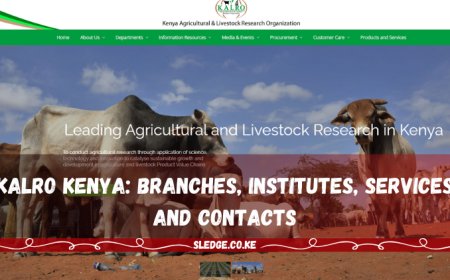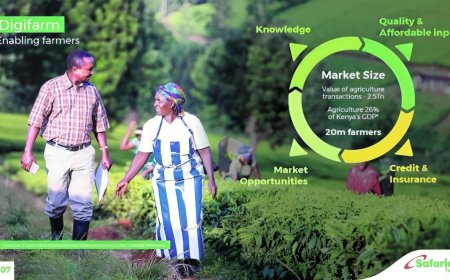HEF Loans and Scholarships 2024/2025 Application Without National ID in Kenya: Your Complete Application Guide
Learn how to apply for university loans and scholarships in Kenya without a national ID. Find out the eligibility requirements and steps to secure funding for your higher education.

Welcome to a pivotal guide on navigating the Higher Education Financing (HEF) in Kenya for the academic years 2024/2025. As a stepping stone into higher education, understanding the intricacies of financial aid, particularly loans and scholarships, is essential. In Kenya, the HEF initiative is a beacon of hope for countless students, offering a lifeline to those embarking on their university or college journeys.
This year, a significant shift in the HEF application process could fundamentally alter the landscape of higher education funding in Kenya. The most notable change? The option to apply for HEF loans and scholarships without a National ID. This adjustment opens doors for students who previously faced barriers due to ID constraints.
But why does this matter? In Kenya, where education is both a privilege and a path to better opportunities, access to funding can make all the difference. For many, the journey to a diploma or degree is fraught with financial hurdles. The ability to apply for financial aid without a National ID broadens access and embodies a step towards inclusive education.
This comprehensive guide will dive into the depths of HEF loans and scholarships. From understanding the nuts and bolts of the HEF model to decoding the application process without a National ID, we've got you covered. Whether you're a prospective university student, a parent navigating the maze of higher education funding, or a curious mind, this guide promises to shed light on every aspect of HEF loans and scholarships in Kenya.
READ ALSO: CUEA Student Portal Guide: Registration, Login , Contacts, Features, and ODEL Explained in 2024
Overview of HEF Loans and Scholarships in Kenya
In the heart of Kenya's educational landscape lies a critical financial support system, the Higher Education Financing (HEF). This initiative is more than just a funding program; it's a lifeline that nurtures the academic dreams of countless Kenyan students. With its roots deeply entrenched in the pursuit of educational equity, HEF stands as a testament to the country's commitment to fostering an environment where every student, regardless of their financial background, has a shot at higher education.
The HEF Model: A Student-Centered Approach
The Higher Education Financing model in Kenya is an innovative, student-centered approach. Unveiled by the Kenyan government, the HEF is designed to address the challenges of massive enrolment and inadequate funding in public universities and TVET (Technical and Vocational Education and Training) colleges. Unlike traditional funding methods that rely on block funding, the HEF model adopts a more personalized approach, apportioning loans, scholarships, and bursaries based on each student's assessed level of need. This means that the testing instrument, known as the MTI (Means Testing Instrument), plays a pivotal role in determining how much support a student receives, ensuring that the most vulnerable students receive the most significant aid.
Funding Options: Loans, Scholarships, and Bursaries
The HEF provides three primary forms of financial assistance: loans, scholarships, and bursaries. Each of these funding options caters to different student needs. Loans are typically repayable financial aids that help students cover their education costs, offering a practical solution for those who might not afford tuition and other related expenses. On the other hand, scholarships are non-repayable financial aids granted based on various criteria, including financial need, academic merit, or a combination of both. Similar to scholarships, bursaries are non-repayable and often awarded based on financial need, providing additional support for students facing financial hardships.
Eligibility: Who Can Benefit?
The eligibility for HEF loans and scholarships is distinct and inclusive. Generally, undergraduate students placed by KUCCPS (Kenya Universities and Colleges Central Placement Service) in public universities and those in public TVET colleges are eligible to apply. This inclusive eligibility criterion ensures that a wide range of students can access financial support, from those pursuing degree courses to those in vocational training. The essence of this eligibility is to create an equitable platform where students from all walks of life can aspire to higher education without the burden of financial constraints.
The Impact of HEF on Kenyan Students
The introduction of HEF in Kenya marks a monumental shift in how educational funding is approached. By focusing on the specific needs of each student, the HEF model ensures that financial aid is effectively distributed and reinforces the principle of equity in education. This approach is crucial in a country where access to higher education can be a gateway to transforming lives and communities. With HEF, the dream of higher education becomes more accessible, opening up a world of possibilities for young Kenyans eager to make their mark.
Applying for HEF Without a National ID - Is It Possible?
In a significant stride towards inclusive education, the Kenyan Higher Education Financing (HEF) system has opened its doors more expansive, allowing students to apply for scholarships without a National ID. This move addresses a significant barrier that has previously hindered access to higher education for many.
The National ID Challenge
Traditionally, obtaining a National ID in Kenya is a rite of passage at 18, marking the transition to adulthood and eligibility for various civic and financial services, including educational loans. However, this requirement often posed a challenge for young students, especially those under 18 or those who, for various reasons, could not obtain their ID in time for university admission. Recognizing this, the HEF has adapted its policies, allowing students to apply for scholarships using alternative identification methods.
Scholarship Applications Without a National ID
For students lacking a National ID, the opportunity to apply for HEF scholarships is a game-changer. This flexibility allows students to use their Kenya Certificate of Secondary Education (KCSE) index numbers to identify during the application process. This inclusive approach ensures that education remains accessible to all, regardless of their ability to secure a National ID.
The Application Process
Applying for an HEF scholarship without a National ID involves several steps:
- Visit the HEF Portal: Students start by accessing the HEF website.
- Use KCSE Index Number: Instead of the National ID, the KCSE index number is used for identification.
- Fill in Required Details: Students then fill out the necessary information and provide other required documents like admission letters, birth certificates, and passport photos.
- Submit the Application: After filling in all the details and uploading the necessary documents, students can submit their applications for review.
The Significance
This policy shift expands access and signals a commitment to educational equity. The HEF acknowledges the diverse challenges Kenyan students face by allowing applications without a National ID. It takes a significant step towards ensuring these challenges do not hinder their educational aspirations. This move is particularly impactful for younger students and those from marginalized communities, who might face delays or obstacles in obtaining their National ID.
Moving Forward
As the HEF continues to evolve and adapt to the needs of Kenyan students, its willingness to embrace such inclusive policies plays a crucial role in shaping a more equitable educational landscape. This approach benefits individual students and contributes to the broader goal of nurturing an educated, skilled, and inclusive society.
Detailed Application Process for HEF Loans and Scholarships
Navigating Kenya's Higher Education Financing (HEF) application process can be daunting. However, prospective university and college students can smoothly sail through the application process with the right guidance. Here's a detailed walkthrough of the steps involved in applying for HEF loans and scholarships.
Step-by-Step Guide to Applying
1. Initial Preparation
- Gather Essential Documents: Before starting the application, ensure you have all necessary documents. This includes your KCSE and KCPE index numbers, a passport-size photo, a copy of your National ID (for loan applications), a college/university admission letter, and your parents' details.
2. Accessing the HEF Portal
- Visit the Official HEF Website: Go to www.hef.co.ke, the application's central hub.
- Portal Navigation: Click on the 'Portals' section to access the application area.
3. Account Registration
- Create an Account: Register for an account if you are a first-time user, or log in if you already have one.
- Email and Phone Verification: Provide a valid email address and phone number for account verification and future communication.
4. Filling in Personal Information
- Complete Your Profile: Update your personal information, including residential details and academic history.
- Upload Required Documents: Attach digital copies of the necessary documents as specified in the application instructions.
5. Choosing the Funding Type
- Select the Desired Funding: Opt for a scholarship or a loan based on your eligibility and need.
6. Final Submission
- Review Your Application: Carefully review your application to ensure all information is correct and complete.
- Submit: Once satisfied, submit your application.
Key Points to Remember
- Accuracy is Crucial: Ensure that all information is accurate to avoid delays or disqualifications.
- Adherence to Deadlines: Keep track of application deadlines to ensure timely submission.
- Regular Updates: Keep your profile updated, especially if there are changes in your contact information or academic status.
The Importance of a Thorough Application
A well-prepared and thoroughly completed application increases your chances of securing funding and reflects your commitment and seriousness towards your academic journey. The HEF values transparency and diligence, which should be evident in your application process.
Post-Application: What Next?
After submission, regularly check your email and the HEF portal for any updates or feedback on your application. Patience is vital, as the review process might take some time.
Understanding the Funding Model and Eligibility Criteria
Delving into Kenya's Higher Education Financing (HEF) model reveals a nuanced and equitable approach to supporting students' educational aspirations. This part explores the intricacies of the funding model and the eligibility criteria determining who benefits from this vital financial support.
The New Funding Model (NFM) Explained
Student-Centered Approach
- Adaptation to Needs: The NFM is designed to allocate funds based on individual student needs. This means-testing approach ensures that those with the most significant financial challenges receive the most support.
- Components of Funding: The model combines scholarships, loans, and household contributions, each tailored to the student's assessed financial capacity.
Application of the Means Testing Instrument (MTI)
- Assessment Tool: The MTI determines a student's financial need level. It considers factors like household income, the choice of academic program, and other socioeconomic indicators.
Categories of Student Funding
Vulnerable Students
- High Scholarship Allocation: Students classified as vulnerable receive significant scholarship funding, with loans making up a small portion of their package, ensuring that they incur no costs.
Extremely Needy Students
- Balanced Funding Mix: This group receives a mix of scholarships and loans, with a higher proportion of scholarships to ease their financial burden.
Needy Students
- Shared Responsibility: These students receive a combination of scholarships and loans, with a small percentage of fees required to be paid by the students themselves.
Less Needy Students
- Minor Financial Support: Students in this category receive lower scholarship amounts and a higher proportion of loans, reflecting their relatively better financial position.
Eligibility Criteria: Who Qualifies?
Eligibility Requirements
- Undergraduate and TVET Students: The HEF primarily targets students placed by KUCCPS in public universities and TVET colleges.
- Inclusivity in Education: By focusing on students from diverse backgrounds, including those who are vulnerable or needy, the HEF model ensures equitable access to higher education funding.
The Impact of the NFM
Implementing this nuanced funding model signifies a progressive step towards addressing the diverse financial needs of Kenyan students. It embodies a commitment to educational equity, making higher education more accessible and reducing the financial barriers that many students face.
READ ALSO: HELB Post Graduate Scholarship 2024: Requirements, Application Process, Courses, and Fees
Frequently Asked Questions (FAQs)
Can I Apply for HEF Without a National ID?
You can apply for HEF scholarships without a National ID by using your KCSE index number.
What Documents Do I Need for the HEF Loan Application?
Key documents include a valid email, telephone number, KCSE and KCPE index numbers, a passport photo, National ID, admission letter, parents’ details, and guarantors’ information.
Who Is Eligible for HEF Funding?
Eligibility extends to undergraduate and TVET students placed by KUCCPS in public institutions.
How Is Funding Determined?
Funding is based on the Means Testing Instrument (MTI), which assesses each student's financial need.
Is There Support for Vulnerable and Extremely Needy Students?
Vulnerable and highly needy students receive substantial scholarships, with loans making up a smaller portion of their package.
Conclusion
The HEF loans and scholarships program marks a significant stride in Kenya's educational landscape, offering a lifeline to many aspiring students. Its inclusive approach, particularly the option to apply without a National ID, opens doors to higher education that many thought were closed. Students and their families are better equipped to navigate this vital support system by understanding the detailed application process and the nuanced funding model. As we look towards the 2024/2025 academic year, the HEF stands as a beacon of hope, illuminating paths for countless Kenyan students towards achieving their academic dreams.












































































